STROMECTOL – INSTRUCTIONS FOR USE
The drug Stromectol belongs to the group of antihelminthic (anthelmintic) drugs with a narrow spectrum of action. According to the ATC classification, this drug has the code – P02CF01.
ACTIVE SUBSTANCE: IVERMECTIN
REGISTRATION AUTHORIZATION OWNERS:
MSD FRANCE (FRANCE) – Stromectol 3 mg – tab. – 3 mg – – 1999-11-19
MSD FRANCE (FRANCE) – Stromectol 6 mg – tab. – 6.0 mg – – 1993-11-02
Forms of release and dosage of the drug
tab. – 3 mg
tab. – 6 mg
In pharmacies, the drug Stromectol is present in various forms of release and dosages. Manufacturers and marketing authorization holders also tend to differ. Below are all drugs with the name – Stromectol, indicating the dosage form of the dosage and method of application. It is also often important to know the manufacturers of each specific drug. Therefore, under each drug listed below, there is information about which factory and in which country all stages of its production took place.
MECHANISM OF ACTION
Ivermectin belongs to the avermectin group, which has an anti-inflammatory effect by suppressing the production of inflammatory cytokines induced by lipopolysaccharides. The anti-inflammatory properties of topical ivermectin have been observed in animal models of skin inflammation. Ivermectin also kills parasites, mainly through selective binding and high affinity for glutamate-regulated chloride channels found in invertebrate nerve and muscle cells.
Suction
Absorption of ivermectin was evaluated in a clinical study involving adult patients with severe papulopustular rosacea who used the maximum allowable dose of the drug. At steady state (after 2 weeks of treatment), the highest mean (± standard deviation) plasma concentrations of ivermectin were observed within 10 ± 8 hours after drug administration (Cmax 2.1 ± 1.0 ng/ml, range 0.7-4.0 ng/ml), and the highest mean (±SD) AUC0-24h was 36±16 ng×h/mL, range 14-75 ng×h/mL). The systemic exposure of ivermectin reached a plateau by the end of the second week of treatment under steady-state conditions. With longer treatment in phase 3 studies, the rate of systemic exposure to ivermectin remained the same as after two weeks of treatment. Under conditions of equilibrium concentration, the levels of systemic exposure of ivermectin (AUC0-24 h 36 ± 16 ng × h / ml) were lower than after a single oral administration of 6 mg of ivermectin in healthy volunteers (AUC0-24 h 134 ± 66 ng × h / ml).
Distribution
An in vitro study showed that the binding of ivermectin to plasma proteins (mainly albumin) is more than 99%. Significant binding of ivermectin to erythrocytes was not observed.
Metabolism
In in vitro studies using human liver microsomes and recombinant CYP450 enzymes, it was noted that ivermectin is metabolized mainly with the participation of CYP3A4 inhibitors.
In vitro studies have shown that ivermectin does not inhibit CYP450 isoenzymes 1A2, 2A6, 2B6, 2C8, 2C9, 2C19, 2D6, 3A4, 4A11, or 2E1. Ivermectin does not induce the expression of CYP450 enzymes (1A2, 2B6, 2C9, or 3A4) in cultured human hepatocytes. The 2 main metabolites of ivermectin (3′-O-dimethyl ivermectin and 4a-hydroxy ivermectin) were identified in a clinical pharmacokinetic study at the maximum allowable dose of the drug and studied during phase 2 clinical studies. Like the parent compound, the metabolites reached an equilibrium state by the end of the second week of treatment, no accumulation was noted up to week 12. In addition, systemic metabolite exposures (estimated using Cmax and AUC) obtained at a steady state were much lower than those after oral ivermectin.
breeding
The final T1 / 2, on average, was 6 days (approximately 145 hours, range 92-238 hours) in patients who applied the drug to the skin 1 time/day for 28 days during a clinical pharmacokinetic study using the maximum allowable dose of the drug. Excretion from the body depends on the degree of absorption after the external application of the cream.
The pharmacokinetics of ivermectin has not been studied in patients with impaired liver and kidney function.
CONTRAINDICATIONS
hypersensitivity to the active substance or any other component of the drug; pregnancy; breastfeeding period; children under 18 years of age (the safety and efficacy of the drug for this age group have not been studied).
With caution: impaired liver function.
OVERDOSE
There are no reports of cases of overdose of Stromectol.
In case of accidental or significant human exposure to unknown amounts of ivermectin veterinary dosage forms (ingestion, inhalation, parenteral administration or contact with the surface of the body), the following symptoms were most often noted: skin rash, swelling of the face, swelling of the eyelids, headache, dizziness, asthenia, nausea, vomiting, and diarrhea.
Other reported adverse reactions include
- convulsions
- ataxia
- dyspnea
- abdominal pain
- paresthesia
- urticaria
- and contact dermatitis.
Treatment: to prevent absorption of the ingested drug, provoking vomiting and/or urgent gastric lavage, followed by the use of laxatives and other measures to eliminate intoxication, may be indicated. In case of accidental ingestion of the drug, symptomatic therapy is carried out, including parenteral administration of fluids and electrolytes, respiratory support (providing oxygen supply and, if necessary, mechanical ventilation), and vasopressors (in the presence of a pronounced decrease in blood pressure).
INTERACTION WITH OTHER DRUGS
Studies on the study of the interaction of the drug with other drugs have not been conducted.
The concomitant use of Stromectol cream with other topical and systemic preparations for the treatment of rosacea has not been studied.
Caution should be exercised when ivermectin is co-administered with potent inhibitors of CYP3A4, as plasma concentrations of the drug may increase significantly.


Leave a Reply